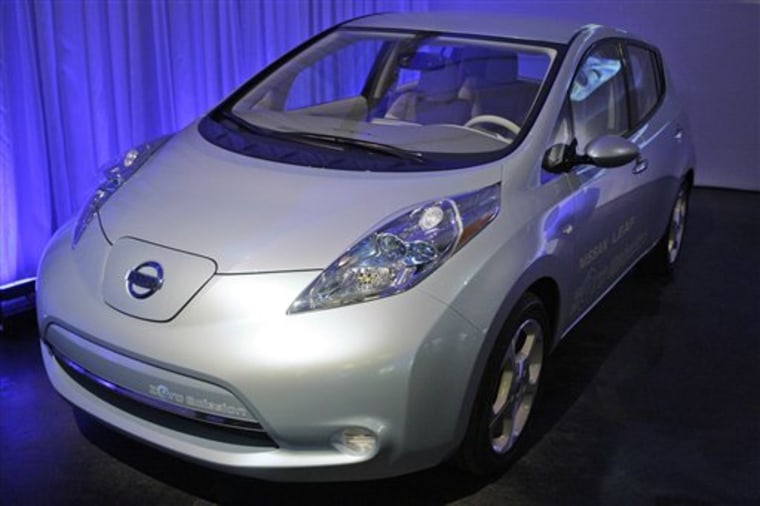The auto industry calls it range anxiety: Drivers want electric cars but worry they won't have enough juice to make long trips. After all, what good is going green if you get stranded with a dead battery?
It's a fear that automakers must overcome as they push to sell more battery-powered cars. So government and business are taking steps to reassure drivers by building up the nation's network of electric charging stations.
The hope is Americans will become more comfortable buying cars such as Nissan's all-electric Leaf, due out late this year, which can travel just 100 miles on a single charge. That's fine for a commute but potentially stressful for longer road trips.
"I think the Leaf is a beautifully designed vehicle, but 50 miles in one direction is just not enough," says Bob Shafron, a former electric car owner in California. "I think they are going to run into problems in markets like LA, where things are spread out."
While automakers and electric car advocates expect most charging to be done at home outlets, those plugs won't help drivers running low on power far from their garages or caught in traffic.
Only a few hundred public chargers exist now, but several government grants totaling more than $115 million will help add thousands more, including in San Diego, Detroit, Washington, D.C., and Bellevue, Wash.
Electric vehicle advocates hope more will be built by private retailers and restaurants, using the charging stations to draw in customers the same way coffee shops offer Wi-Fi.
Public and privately funded chargers are going up in places like rest stops, hotels and McDonald's and Starbucks. Still, even the most optimistic estimates put the number of public charging stations at 16,000 by 2012, tiny compared with the 117,000 gas stations on American roads.
President Barack Obama wants 1 million electric cars on American roads by 2015, but experts say a chicken-and-egg problem is standing in the way. Before enough cars hit the road, private vendors may be reluctant to build many charging stations. And without many charging stations on the road, people may be reluctant to buy the cars.
Most public stations will take eight hours to juice up a car all the way, about the same as chargers in individual homes. These plugs could work for people who have chargers near their offices, but wouldn't work for quick refueling. Even a partial charge will take awhile — two-and-a-half hours to get 30 miles. A limited number of the chargers will be fast-chargers. If you can find one, it will still take 30 minutes for a full powerup.
In 1999, Shafron ran out of power as he was driving his EV1, the all-electric car that General Motors launched in the 1990s and later stopped making, from his beach home to Northridge, Calif. His range meter told him he had 20 miles left, but it quickly ran down to zero.
Difficulty in gauging remaining battery charge was a common issue with the EV1. Varying road conditions like hills and bad weather, which can take a toll on battery life, made the range of early electric cars tough to predict.
Carmakers say that new range meters in today's electric cars are much more accurate.
Whether or not the infrastructure is ready, many automakers will be putting out electric cars, with an estimated 146,000 on the road by the end of 2012.
Tesla, which just took itself public, has sold a little more than 1,000 high-end electric sports cars and plans to offer a lower-priced sedan in the next few years. Nissan has its Leaf, and Ford aims to enter the market with an all-electric Focus in 2012. General Motors Co. will soon sell its part-electric Volt.
The Volt is scheduled for limited release this fall and allows the driver to drive on battery alone for 40 miles before switching on a small gas engine that can take the vehicle up to 300 miles.
As one of the creators of General Motors' failed EV1, Andrew Farah knows the limits of the electric charging network.
"Show me an EV1 owner and I will show you someone who has broken down," said Farah, who cited a lack of a widespread charging network as one reason for the car's failure. Farah is the lead engineer on GM's Volt.
GM's Volt is partly a reaction to the lack of public chargers and the limited range that were factors in the EV1's demise.
As for the Leaf, Nissan said it fills a certain niche but isn't for everyone.
"I would not recommend this car for road trips," said Nissan spokeswoman Katherine Zachary. "We see this as a city car, a commuter car."
Nissan points out that most people drive well within the 100-mile range in a given day and that the Leaf will primarily serve those with regular driving routines. Government data backs that up, with about 78 percent of Americans driving 40 miles or fewer to and from work, according to the Department of Transportation.
But many Americans drive longer distances for family trips and vacations. Over Memorial Day weekend, vacationers had planned to travel an average of 626 miles both ways, with the vast majority of trips by car, AAA said.
Tom Moloughney, a 43-year-old New Jersey restaurant owner, is part of a test lease program for BMW's all-electric Mini-E. He said that electrics work well for two-car households, with the electric as the primary commuting vehicle and a gas car for longer trips and vacations.
Moloughney said that range anxiety is manageable — you just have to plan your trips carefully and know how far you're going.
"You are not gripping the steering wheel with white knuckles. You plan your trips and plan for how far you are going."
